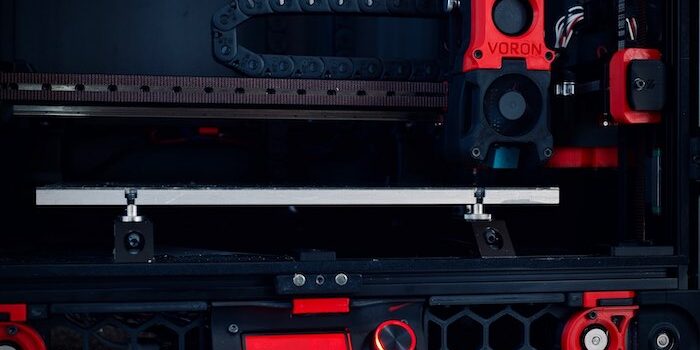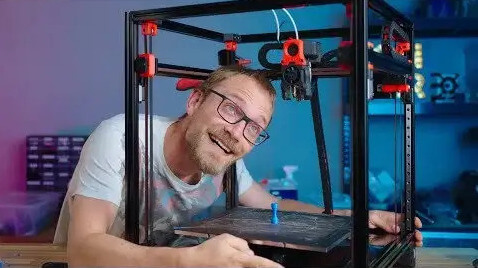
Have you ever wanted to 3D print engineering plastics like ABS and nylon but felt overwhelmed by the expensive and complicated options on the market? Well, you’re in luck! With Voron 3D Printer, you’ll have access to a low-cost solution that will make your 3D printing dreams come true.
With these easy-to-build entry-level 3D printers, you can learn the basics of 3D printing without spending an arm and a leg. Plus, they don’t skimp on quality—they’re designed for professional-grade materials like ABS and nylon so you can create reliable parts for any project. And best of all, if something goes wrong or breaks down, it’s easy to fix with DIY parts.
So why wait? Get started building your very own 3D printer today! With Voron DIY 3D printers, you’ll have access to reliable and affordable solutions for all of your 3D printing needs. Let’s get printing!
How to Pick the Perfect Voron 3D Printer
Table of Contents
- How to Pick the Perfect Voron 3D Printer
- Choosing Best Voron 3D Printer
- Pros and Cons of Owning a Voron 3D Printer
- Tips for Using and Maintaining Your Voron 3D Printer
- Frequently Asked Questions about Voron 3D Printers
- What is Voron used for?
- How easy is it to use a Voron 3D printer?
- Do I need any special tools or hardware for assembly?
- What type of printer is voron?
- What is voron design?
- Can I print with multiple materials?
- How good are voron printers?
- How long does it take to print a voron?
- How easy is assembly?
- Is it possible to upgrade my 3D printer?
- Conclusion: Voron 3D Printer
So what’s the perfect Voron 3D Printer for you? Let’s start with the basics:
Size and Weight Matter
Domestic use usually requires a smaller, lighter machine. If you’re looking to do professional or industrial work, consider going bigger and heavier. What type of printer is it? FDM printers have a heated head that melts filament, while SLA printers use lasers or light sources to cure resin layer by layer from the bottom up.
Printing Speed
Printing speed depends on the printer you choose, but in general, an FDM printer will be much faster than an SLA.
Material Options
For engineering applications, ABS and nylon are both good choices. Both materials have excellent heat resistance and mechanical strength. PLA is also a great choice for prototyping or low-volume production.
Noise Level
The noise level will depend on the type of printer you get, but most FDM printers are relatively quiet compared to SLA printers.
Price
The cost of the Voron 3D Printer will depend on the size and features you choose, but you can expect to pay anywhere from a few hundred dollars for a basic entry-level model up to several thousand dollars for an industrial-grade model. No matter what your needs are, Voron has a DIY 3D printer that’s perfect for you. With easy assembly, low cost, and high-quality materials.
Power Consumption
The amount of electricity consumed will depend on the model you choose, most FDM printers are relatively low power compared to SLA printers.
Build Volume
The build volume of a printer is how large of an item it can print. The larger the build volume, the bigger items you can print. For most users, having a larger build volume is not necessary, but for industrial applications, it can be very useful.
Materials Capabilities
Voron DIY 3D printers are capable of printing a variety of materials, including PLA, ABS, PETG, and Nylon. PLA is a great material for low-stress parts and prototyping, while ABS and nylon are great for engineering applications due to their superior heat resistance and strength.
Connectivity Features
Voron DIY 3D printers come with a variety of connectivity features, such as Wi-Fi and USB. This makes it easy to print from anywhere using your laptop or smartphone. Additionally, Voron also offers advanced features like remote monitoring and cloud storage.
Print Resolution
The print resolution of a printer will depend on the model you choose. Most Voron 3D printers offer resolutions down to 0.1mm, making them suitable for detailed and precise parts.
Safety Features
Voron DIY 3D printers come with built-in safety features such as an enclosed build chamber and automatic shut-off when temperatures get too high or if there is an error. They also feature failsafe controls that can detect when something is wrong and power down the printer before it becomes a hazard.
Filament Type
Voron 3D printers can print a variety of filaments, including PLA, ABS, PETG, and Nylon. Each filament type has its own unique properties and uses, so it’s important to decide which one is right for your project before purchasing.
Software tools
Voron DIY 3D printers come with a variety of software tools to help you get the most out of your printing experience. Some models come with their own slicing and modeling software, while others can be used with third-party programs like Cura and Slic3r. Additionally, Voron also offers advanced features like Wi-Fi connectivity and cloud storage for easy remote printing.
Compatibility
Voron DIY 3D printers are compatible with both Mac and Windows operating systems, making it easy to get started with 3D printing regardless of your computer setup.
Support/Maintenance
Voron’s DIY 3D printers come with a warranty, and their customer service team is available 24/7 for any questions or technical support. Additionally, Voron offers tutorials and videos to guide you through the setup process and answer any other questions you may have.
Also Check: Delta 3D Printer
Choosing Best Voron 3D Printer

There are 5 Voron 3D Printers to choose from:
- Voron 0
- Voron 1 (Trident)
- Voron 2
- Voron Switchwire
- Voron Legacy
Voron 0
A budget-friendly printer with a build volume of 200 x 200 x 250 mm and a 0.1mm print resolution, the Voron 0 is perfect for hobbyists and entry-level users.
Voron 1 (Trident)
The flagship 3D printer from Voron, the Trident features a large 300 x 300 x 400 mm build volume, 0.1mm print resolution, dual extruders, and more!
Voron 2
This mid-range 3D printer offers an impressive 200 x 200 x 250 mm build volume and 0.1mm print resolution. It also has WiFi connectivity for remote printing.
Voron Switchwire
This budget-friendly model sacrifices some of the features found in higher-end models but still packs a punch with a 200 x 200 x 250 mm build volume and 0.1mm print resolution.
Voron Legacy
The Legacy 3D printer is ideal for users who want a large, 400 x 400 x 500 mm build volume that’s perfect for industrial applications. It also offers 0.1mm print resolution and dual extruders.
Also Check: Voron 2.4 Kit
Pros and Cons of Owning a Voron 3D Printer
The advantages of owning a Voron 3D Printer include
- Affordable pricing
- Variety of connectivity features
- High print resolution
- Safety features for increased safety
- Compatible with Mac and Windows operating systems
- 24/7 customer support
Disadvantages of owning a Voron 3D Printer include
- Assembly is required, which can be time consuming
- Limited materials available for printing
Tips for Using and Maintaining Your Voron 3D Printer
1. Read through the included manual before starting assembly and use it to get familiar with your printer.
2. Use a leveled bed for the best print quality.
3. Clean the build plate regularly to ensure good adhesion of the filament to the surface of the part being printed.
4. Perform regular maintenance on your 3D printer, such as replacing worn parts and cleaning extruder nozzles when needed.
5. Store filaments in an airtight container away from direct sunlight or humidity to avoid clogging or degradation of filament performance over time.
6. If using multiple materials in one project, keep track of which material is being used at what point in order to avoid confusion and potential errors due to incorrect filaments being used.
7. Always keep the printer in an area with ventilation, away from dust and debris that can clog up your 3D printer’s components.
Also Check: CoreXY 3D Printer Reviews
Frequently Asked Questions about Voron 3D Printers
What is Voron used for?
Voron 3D Printers are used to create three-dimensional objects, parts, and prototypes from plastic filaments.
How easy is it to use a Voron 3D printer?
Voron’s DIY 3D printers are designed for users with all levels of experience, making them great for people just starting out with 3D printing. The included software makes it simple to get started right away.
Do I need any special tools or hardware for assembly?
No, all you need to assemble your Voron 3D printer is the included parts and tools.
What type of printer is voron?
Voron 3D printers are a type of Fused Filament Fabrication (FFF) style printer which uses plastic filaments to create three-dimensional objects.
What is voron design?
Voron design is a modular approach to 3D printing that allows users to reconfigure their printers based on the needs of their current project. This enables users to maximize their printer’s performance and efficiency, as well as allowing for upgrades as needed. It also simplifies the troubleshooting process by isolating any potential problems to one specific module or component.
Can I print with multiple materials?
Yes, Voron’s dual extruder models allow you to print with two different filaments simultaneously, giving you the flexibility to create multi-material prints. However, if using multiple materials in one project, it is important to keep track of which material is being used at what point in order to avoid confusion and potential errors due to incorrect filaments being used.
How good are voron printers?
Voron’s 3D printers are designed for users who want to take their printing to the next level. With features like a large build volume, easy assembly and upgradeability, high print resolution, dual extruders, and safety feature all at an affordable price, you’ll find that Voron is one of the best FDM 3D printing solutions on the market.
How long does it take to print a voron?
The time it takes to print with a Voron 3D printer varies from project to project, but the average print time is usually between 2-6 hours. The size and complexity of your design, as well as the type of filament being used, can all affect how long it will take to complete your print job.
How easy is assembly?
Assembly is relatively straightforward; most users can assemble their printer in a few hours. If you get stuck, there are plenty of online resources available to help guide you through the process.
Is it possible to upgrade my 3D printer?
Yes, you can upgrade certain components of your Voron 3D Printer, such as the extruder and bed. Check with Voron’s customer service team for more information about available upgrades.
Conclusion: Voron 3D Printer
Voron 3D Printer is an ideal choice for those looking to create three-dimensional objects, parts, and prototypes from plastic filaments. With their easy assembly process, modular design, and upgradeability, Voron printers are perfect for users of all levels of experience. Plus, the included safety features make sure your prints come out looking their best every time. So if you’re in the market for a 3D printer that offers great value combined with powerful performance capabilities, then look no further than Voron!
Take the plunge today and get ready to unleash your creativity with Voron 3D Printers!
